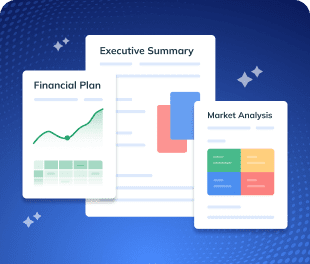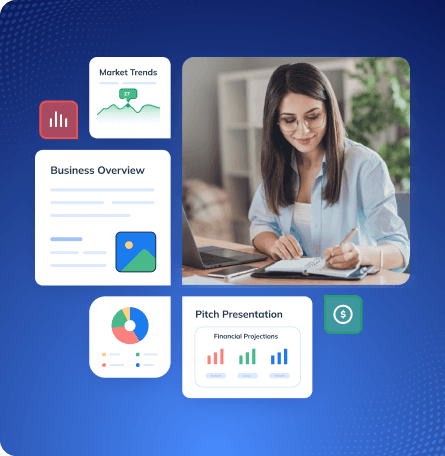Starting or growing a record label sounds exciting: Discovering new talent, creating great music, and building a brand that connects with fans.
But there’s a lot that happens behind the scenes. From signing artists to managing contracts and promoting releases, you’ll need more than just a passion for music. You’ll need a solid business plan.
One that helps you plan everything from your artist strategy to your marketing approach, without any guesswork.
Not sure where to start?
This record label business plan template is here to guide you through the process!
How to draft a record label business plan?
Well, writing a successful record label business plan involves several actionable steps to cover all your business aspects, such as your goals, strategies, and even finances.
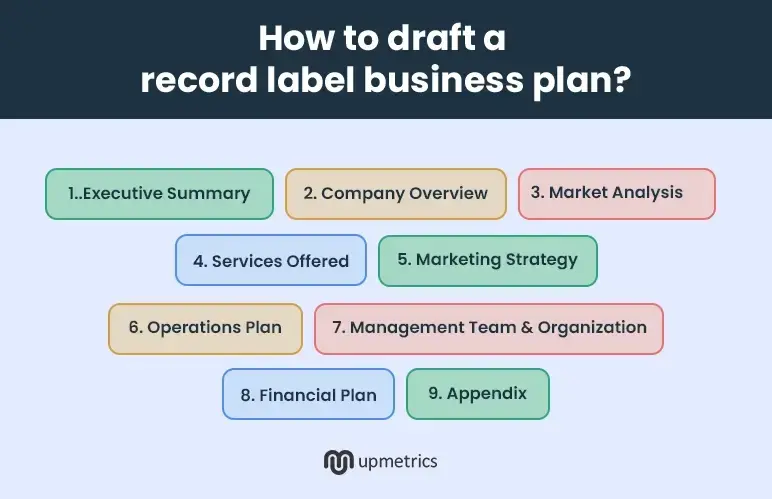
Let’s dive into the record label business plan outline and guide on how to draft each section effectively.
1. Executive Summary
The executive summary is a snapshot of your entire record label business plan—essentially an elevator pitch for your label.
This section highlights the most important aspects of your plan to give readers (potential investors, partners, or loan officers) a clear idea of your label’s scope and potential.
Even though it appears first, it’s often easiest to write this section last, once you’ve completed all other sections. This way, you can pick the key points from each to present clearly.
While planning your executive summary, try to cover these points:
- Label name & location: Where your label is based and what it’s called.
- Business concept: The type of label you’re starting and the genres of music you’ll focus on.
- Target market: Who your ideal artists and fans are, and what makes them a good fit for your label.
- Competitive advantage: What sets your label apart from others in the industry?
- Financial highlights: A brief overview of funding needs, revenue projections, and profitability.
- Business goals: Your short-term and long-term goals for the label.
Remember, this section should grab the reader’s attention and encourage them to continue reading the rest of your plan. Keep it positive, confident, and concise (aim for one to two pages).
Say goodbye to boring templates
Build your business plan faster and easier with AI
Plans starting from $14/month

2. Company Overview
This section provides a detailed portrait of your record label at a high level. It clearly explains who you are, what you plan to do, and why. Think of it as an introduction to your label’s story and objectives.
Keep the writing straightforward and factual while conveying excitement for the project. This foundational section sets the tone for the rest of your plan.
Here are the key elements to include in your company overview:
- Company name and legal structure: Introduce the name of your record label and the business entity (e.g., sole proprietorship, LLC, partnership).
- Location and operational details: Describe where your label is based and any relevant operational details. Are you based in a major city or a smaller town? Do you plan to expand into new locations or have an online presence?
- Founding team and ownership: Introduce the founder(s) or key owners. If you have partners or investors, mention them. For example, maybe you’re two producers who started the label after seeing a gap in the local scene.
- Mission and vision: State your mission (the purpose of your record label) and vision (what you hope to achieve in the long run).
- Future goals and objectives: List a few short-term and long-term goals you aim to achieve. For example, releasing three EPs in the first year, or growing the label into a brand that also sells merchandise, or hosts events.
In short, the company overview section should clearly articulate what your record label is and aims to be. By the end of this section, the reader should fully understand your label’s concept, the gap it fills or problem it solves, and what drives it forward.
3. Market analysis
A thorough market analysis shows that you have researched the music industry and understand the market dynamics you’re entering.
This section is crucial for convincing readers that there is a real demand for your record label and that you understand your target market and competition. It typically includes a few sub-sections:
Industry Overview
Provide an overview of the music industry, particularly the niche your record label is targeting. Include current market size, growth potential, and trends that are shaping the music business today. This context demonstrates that you have a strong grasp of the broader music scene.
Target Market
Identify your target audience: Who are you aiming to serve with your label? Are you focusing on independent artists, a specific genre of music, or niche audiences?
Define their demographics (age, income, location) and psychographics (interests, music preferences, lifestyle).
Segment
| Demographics | Psychographics |
|---|---|
| Independent Artists | 20–35 years, mid-income, diverse backgrounds |
| Genre-Specific Fans | 18–40 years, varied income levels |
| Niche Audiences | 25–45 years, higher income |
Location Analysis
If your label is local or region-specific, analyze the local music scene and demand for your services.
How many people in your area are listening to the genre you’re focusing on? Are there music venues or events that draw crowds? Highlight any advantages your location offers, such as proximity to music hubs, local talent, or industry events.
Market Needs and Trends
Discuss the current market needs and trends in the music industry. For example, you might mention the rise of indie music streaming, the growing demand for live events, or the lack of labels supporting underrepresented genres.
Address any unmet needs that your label will fill. For instance, if there’s a demand for a label that focuses on eco-conscious music or promotes diversity in music genres, highlight that here.
Competitor Analysis
Identify other labels similar to yours. Direct competitors might be local labels or labels in the same genre. Indirect ones could include major labels or DIY platforms (artists self-releasing music).
How will you stand out? Perhaps you offer better royalty splits, a unique community vibe, or a specialized genre focus.
SWOT Analysis
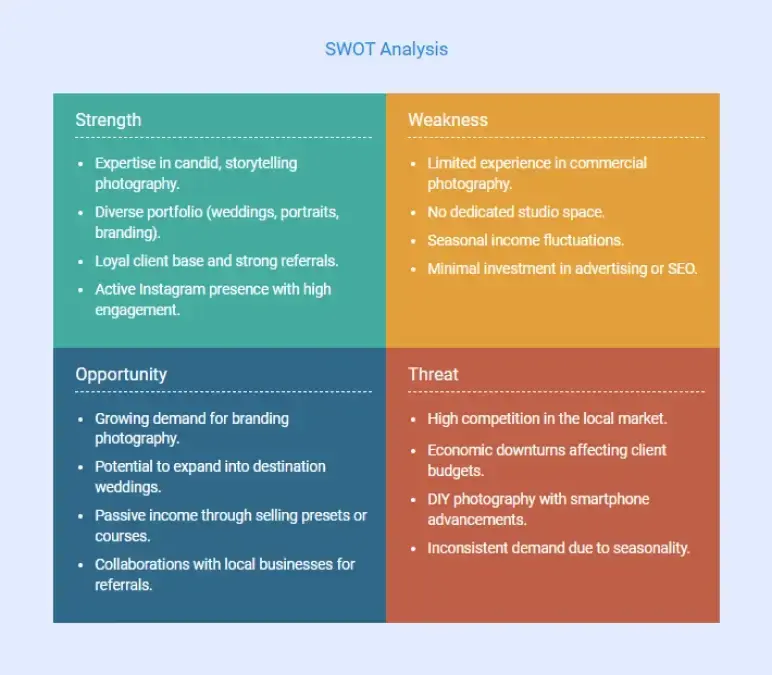
Conducting a detailed market analysis helps you and your readers validate the business potential of your record label. Use reliable data and statistics (from music associations, streaming platforms, market reports, etc.) to back up your points.
4. Services Offered
This section of your record label business plan details exactly what you’re offering to artists and listeners—basically, how your label will generate income and serve its target audience.
Start by outlining your core offerings. For a record label, this typically includes services like:
- Music releases: Digital downloads, vinyl records, CDs, and other formats.
- Artist development: Studio recording, marketing, and gig booking.
- Genres or niches: Music genres you focus on, such as hip-hop, EDM, indie rock, etc.
- Events: Label showcases, concerts, and live performances.
- Merchandise: T-shirts, vinyl, stickers, and other label-branded products.
Next, list other services or features that will enhance the artist and listener experience. For example:
- Distribution through platforms like DistroKid or TuneCore.
- Music licensing for TV shows, movies, or video games.
- Music publishing and rights management.
Lay out any value-added services that are part of your label’s business model. You might also plan to sell:
- Limited-edition album releases.
- Exclusive artist collaborations or behind-the-scenes content.
Also, don’t forget to discuss how you plan to distribute your music. Will it be available on major streaming platforms, through third-party distributors, or by partnering with other labels?
While writing this section, focus on the benefits to both artists and listeners. It’s not just a list of services—it’s about how these offerings meet the needs of your target audience, whether that’s through better promotion, distribution, or unique music experiences.
5. Marketing Strategy
Having a strong music label is one thing, but you also need a solid marketing strategy to reach your audience and grow your fan base.
This section of your business plan outlines how you will promote your label, attract listeners, and maintain a growing following in a competitive industry.
Here’s what to cover in your marketing strategy:
- Setting clear marketing goals (e.g., reaching 5,000 Instagram followers in Year 1, achieving a specific number of streams per release)
- Engaging your target market, such as 18-30-year-old electronic music fans or lo-fi hip-hop listeners
- Establishing a strong branding image—whether edgy and underground or polished and artist-friendly
- Focusing on key social media platforms (Instagram, TikTok, Twitter) to engage with followers and promote new releases
- Reaching out to music press, blogs, and YouTube channels to gain exposure
- Pitching tracks to Spotify/Apple Music playlists or local radio stations for added visibility
Your marketing strategy should be realistic and targeted. You don’t need a massive budget to effectively promote your label if you smartly use online channels and local networks.
However, do allocate some budget for marketing in your financial plan.
6. Operations Plan
The operations plan section details the day-to-day running of your record label. How will you ensure smooth operations and consistently release high-quality music?
This section gives readers insight into the practical aspects of running a record label efficiently. It’s especially important if you’re seeking funding, as lenders/investors want to know you have a clear execution plan.
Consider answering these questions while drafting your operations plan:
- Who will manage the record label, and what staff roles will you need?
- What’s your plan for A&R, music production, and talent scouting? How often will these tasks be done?
- How will you manage artist signings and the recording process?
- What’s your release preparation and distribution process?
By covering these operational details, you reassure readers that you have a clear understanding of the practical aspects of running your record label.
It shows that managing a record label is not a “set and forget” business but requires ongoing effort and attention to ensure success.
7. Management Team and Organization
Investors and partners frequently state that they invest in individuals as much as in ideas. Your management team page is your opportunity to introduce the principal individuals who make up your record label and why they’re qualified to take it to success.
To organize this section well, initially introduce yourself as the founder/owner of the label, with any co-founders (in case there are any).
Give a short bio for each team member, emphasizing relevant skills and experience. If you have music industry experience, whether it’s in music production, artist management, or marketing, be sure to highlight it. Even indirect experience can be valuable!
If you have a very small team or your key management personnel, be specific about each person’s job and what their responsibilities will be. One may do the A&R (Artist and Repertoire), the other marketing, and the other finance. Be clear about specifying who will look after each end of the business.
Also, include a basic organizational chart to reflect your label’s team structure and decision-making process. Here’s an example:
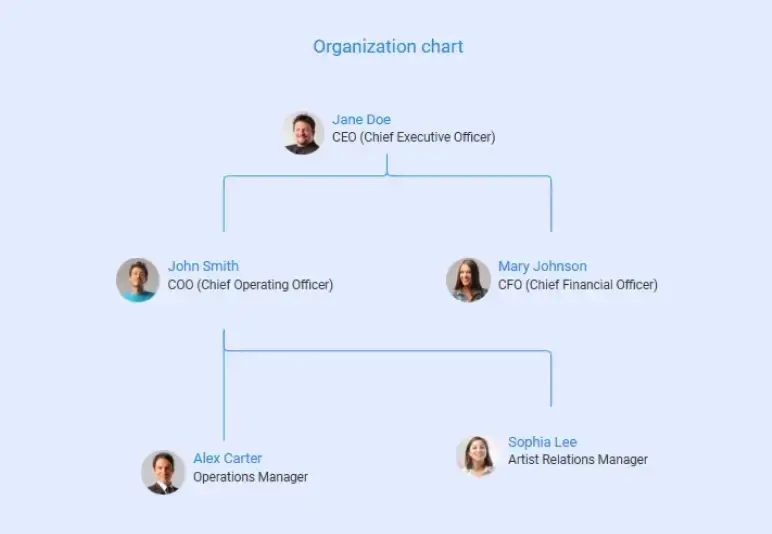
If you have mentors, advisors, or consultants with industry experience, be sure to mention them as well. This shows that you have access to experienced guidance, which can strengthen your team’s credibility.
8. Financial Plan
The financial plan is where you take all the ideas and plans you’ve outlined and turn them into numbers.
This section shows how financially feasible your record label is and is often closely examined by investors or lenders. Well-thought-out and realistic projections give confidence that your label will be profitable and sustainable.
Your record label’s financial plan should typically include forecasted financial statements for the next 3-5 years. Here are the key components to include:
- Income statement (profit and loss statement): This shows your expected revenue and expenses, helping to understand profits or losses.
- Cash flow statement: This tracks money coming in (from sales, streaming, artist contracts) and going out (for expenses, loan payments, etc.) on a monthly or quarterly basis.
- Break-even analysis: The estimated revenue needed to cover all your costs and become profitable.
- Balance sheet: Expected assets (cash, equipment, intellectual property), liabilities (loans, accounts payable), and equity.
- Risk management plan: Explain how you will handle risks such as fluctuating revenue, competition, or changes in the music industry landscape.
Additionally, provide your assumptions (such as revenue from streaming, concert income, artist signing fees, etc.) in narrative form and ensure your numbers are aligned with these assumptions.
It’s also a good idea to outline any financial buffer or contingency plans. Revenue for record labels can depend on multiple factors like the success of artists or sales, so showing a backup plan—whether it’s a line of credit or reserved funds—demonstrates smart planning.
9. Appendix
The appendix is the final section of your business plan, where you include supporting documents that back up your plan. It’s optional, but helpful for strengthening your case.
You might include sample contracts (like artist agreements), resumes of the founders, detailed budget sheets for your first music release, and marketing materials (such as logo mockups or promo posters).
Letters of intent or support, market research data, and an equipment list can also be useful. If relevant, you could add organizational policies like a Code of Ethics or diversity policy.
The appendix is where you can add extra details that support your business. Refer to it in the main sections, like “(see Sample Artist Contract in Appendix),” so readers know where to find more information.
Why do you need a business plan for a record label?
A business plan for a record label is a formal, living document that serves as a strategic roadmap for your label’s success and helps you navigate the complexities of the music industry.
Here’s why it’s essential:
- Clarifies your vision by defining what your label stands for–your brand identity, the genres you’ll focus on, and your unique value proposition.
- Guides decision-making when you face tough choices, helping you align your decisions with your label’s long-term goals.
- Attracts artists and collaborators by demonstrating that you have a well-defined, professional plan, making you more reliable to collaborate with.
- Prepares you for setbacks by enabling you to anticipate setbacks (i.e., budget concerns or distribution hitches) and have contingency plans in place.
In short, a good business plan lays a solid foundation for your record label and keeps you on track from beginning to end!
Download a free record label business plan template
Ready to start drafting your record label business plan from scratch, but need a little extra help? No worries – download our free sample record label business plan PDF to get started.
This template has already helped many label owners successfully kick-start their businesses, and we hope it can do the same for you. Use it as a guide while drafting your record label plan, or feel free to customize it to match your unique vision and goals.
The Quickest Way to turn a Business Idea into a Business Plan
Fill-in-the-blanks and automatic financials make it easy.
Summary
Now that you’ve gone through this guide and have a free template, drafting your business plan for your record label should be much easier.
If you’re still unsure about some details or want a simpler way to write your plan, Upmetrics is here to help. It’s a modern business planning software that makes the process easier with its intuitive features.
It also offers tools like financial forecasting, market analysis, and business resources to help you create a detailed, professional plan that can win over investors.
